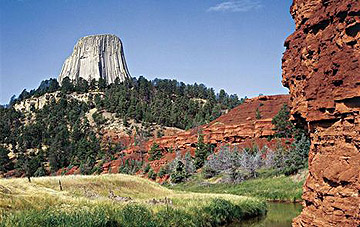- Home
- Encyclopedia
- Devils Tower
Devils Tower

In 1906, President Theodore Roosevelt brought national attention to Devils Tower by authorizing the Antiquities Act, giving the president the power to set aside national monuments. Devils Tower became the first national monument, established that same year.
Rising 1,267 feet above the Belle Fourche River, Devils Tower is hard to miss. In fact, the formation of this distinctive rock figures prominently in the sacred legends of several American Indian groups who know the tower as Bear Lodge or Bear’s Tipi, among other names. Today, more than 20 tribes have established ties to the tower, and many groups visit the site to perform traditional ceremonies every year.
The tower of columnar basalt formed when molten rock intruded into overlying sedimentary rock and cooled into columns, which developed vertical cracks as they shrank. Eventually the overlying rock eroded to reveal the igneous rock beneath.
Resources
- Gunderson, Mary Alice. Devils Tower: Stories in Stone. Glendo, Wyo.: High Plains Press, 1988.
- National Park Service. “Devils Tower National Monument, Wyoming,” accessed 9/17/11 at http://www.nps.gov/deto/
- Norton, Steven L. Devils Tower: The Story behind the Scenery. Wickenburg, AZ: K.C. Publishing, Inc., 1991.
- Rogers, Jeanne. Standing Witness: Devils Tower National Monument, a History. Devils Tower National Monument: National Park Service, 2008.
- Wyoming Tourism. “Devils Tower National Monument,” accessed 9/9/11 at http://wyomingtourism.org/cms/d/devils_tower_national_monument.php
Illustration
- The photo of Devils Tower is from the Wyoming Official State Travel Website. Used with thanks.
